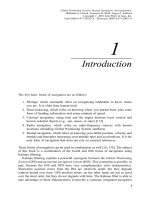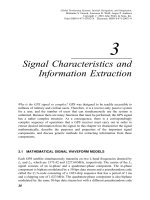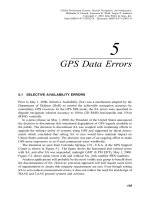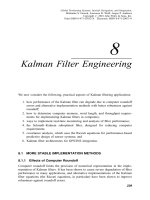GPS - đường dẫn quán tính và hội nhập P1
Bạn đang xem bản rút gọn của tài liệu. Xem và tải ngay bản đầy đủ của tài liệu tại đây (60.48 KB, 8 trang )
1
Introduction
The ®ve basic forms of navigation are as follows:
1. Pilotage, which essentially relies on recognizing landmarks to know where
you are. It is older than human kind.
2. Dead reckoning, which relies on knowing where you started from, plus some
form of heading information and some estimate of speed.
3. Celestial navigation, using time and the angles between local vertical and
known celestial objects (e.g., sun, moon, or stars) [115].
4. Radio navigation, which relies on radio-frequency sources with known
locations (including Global Positioning System satellites).
5. Inertial navigation, which relies on knowing your initial position, velocity, and
attitude and thereafter measuring your attitude rates and accelerations. It is the
only form of navigation that does not rely on external references.
These forms of navigation can be used in combination as well [16, 135]. The subject
of this book is a combination of the fourth and ®fth forms of navigation using
Kalman ®ltering.
Kalman ®ltering exploits a powerful synergism between the Global Positioning
System (GPS) and an inertial navigation system (INS). This synergism is possible, in
part, because the INS and GPS have very complementary error characteristics.
Short-term position errors from the INS are relatively small, but they degrade
without bound over time. GPS position errors, on the other hand, are not as good
over the short term, but they do not degrade with time. The Kalman ®lter is able to
take advantage of these characteristics to provide a common, integrated navigation
1
Global Positioning Systems, Inertial Navigation, and Integration,
Mohinder S. Grewal, Lawrence R. Weill, Angus P. Andrews
Copyright # 2001 John Wiley & Sons, Inc.
Print ISBN 0-471-35032-X Electronic ISBN 0-471-20071-9
implementation with performance superior to that of either subsystem (GPS or INS).
By using statistical information about the errors in both systems, it is able to
combine a system with tens of meters position uncertainty (GPS) with another
system whose position uncertainty degrades at kilometers per hour (INS) and
achieve bounded position uncertainties in the order of centimeters [with differential
GPS (DGPS)] to meters.
A key function performed by the Kalman ®lter is the statistical combination of
GPS and INS information to track drifting parameters of the sensors in the INS. As a
result, the INS can provide enhanced inertial navigation accuracy during periods
when GPS signals may be lost, and the improved position and velocity estimates
from the INS can then be used to make GPS signal reacquisition happen much faster
when the GPS signal becomes available again.
This level of integration necessarily penetrates deeply into each of these
subsystems, in that it makes use of partial results that are not ordinarily accessible
to users. To take full advantage of the offered integration potential, we must delve
into technical details of the designs of both types of systems.
1.1 GPS AND GLONASS OVERVIEW
1.1.1 GPS
The GPS is part of a satellite-based navigation system developed by the U.S.
Department of Defense under its NAVSTAR satellite program [54, 56, 58±63, 96±
98].
1.1.1.1 GPS Orbits The fully operational GPS includes 24 or more (28 in
March 2000) active satellites approximately uniformly dispersed around six circular
orbits with four or more satellites each. The orbits are inclined at an angle of 55
relative to the equator and are separated from each other by multiples of 60
right
ascension. The orbits are nongeostationary and approximately circular, with radii of
26,560 km and orbital periods of one-half sidereal day (%11:967 h). Theoretically,
three or more GPS satellites will always be visible from most points on the earth's
surface, and four or more GPS satellites can be used to determine an observer's
position anywhere on the earth's surface 24 h per day.
1.1.1.2 GPS Signals Each GPS satellite carries a cesium and=or rubidium
atomic clock to provide timing information for the signals transmitted by the
satellites. Internal clock correction is provided for each satellite clock. Each GPS
satellite transmits two spread spectrum, L-band carrier signalsÐan L
1
signal with
carrier frequency f
l
1575:42 MHz and an L
2
signal with carrier frequency
f
2
1227:6 MHz. These two frequencies are integral multiples f
1
1540f
0
and
f
2
1200f
0
of a base frequency f
0
1:023 MHz. The L
1
signal from each satellite
uses binary phase-shift keying (BPSK), modulated by two pseudorandom noise
(PRN) codes in phase quadrature, designated as the C=A-code and P-code. The L
2
2
INTRODUCTION
signal from each satellite is BPSK modulated by only the P-code. A brief description
of the nature of these PRN codes follows, with greater detail given in Chapter 3.
Compensating for Propagation Delays This is one motivation for use of two
different carrier signals L
1
and L
2
. Because delay varies approximately as the inverse
square of signal frequency f (delay G f
À2
), the measurable differential delay
between the two carrier frequencies can be used to compensate for the delay in
each carrier. (See [86] for details.)
Code Division Multiplexing Knowledge of the PRN codes allows users indepen-
dent access to multiple GPS satellite signals on the same carrier frequency. The
signal transmitted by a particular GPS signal can be selected by generating and
matching, or correlating, the PRN code for that particular satellite. All PRN codes
are known and are generated or stored in GPS satellite signal receivers carried by
ground observers. A ®rst PRN code for each GPS satellite, sometimes referred to as
a precision code or P-code, is a relatively long, ®ne-grained code having an
associated clock or chip rate of 10f
0
10:23 MHz. A second PRN code for each
GPS satellite, sometimes referred to as a clear or coarse acquisition code or C=A-
code, is intended to facilitate rapid satellite signal acquisition and hand-over to the P-
code. It is a relatively short, coarser grained code having an associated clock or chip
rate f
0
1:023 MHz. The C=A-code for any GPS satellite has a length of 1023 chips
or time increments before it repeats. The full P-code has a length of 259 days, during
which each satellite transmits a unique portion of the full P-code. The portion of P-
code used for a given GPS satellite has a length of precisely one week (7.000 days)
before this code portion repeats. Accepted methods for generating the C=A-code and
P-code were established by the satellite developer
1
in 1991 [42, 66].
Navigation Signal The GPS satellite bit stream includes navigational information
on the ephemeris of the transmitting GPS satellite and an almanac for all GPS
satellites, with parameters providing approximate corrections for ionospheric signal
propagation delays suitable for single-frequency receivers and for an offset time
between satellite clock time and true GPS time. The navigational information is
transmitted at a rate of 50 baud. Further discussion of the GPS and techniques for
obtaining position information from satellite signals can be found in Chapter 3 and
in [84, pp. 1±90].
1.1.1.3 Selective Availability Selective Availability (SA) is a combination of
methods used by the U.S. Department of Defense for deliberately derating the
accuracy of GPS for ``nonauthorized'' (i.e., non±U.S. military) users. The current
satellite con®gurations use only pseudorandom dithering of the onboard time
reference [134], but the full con®guration can also include truncation of the
1
Satellite Systems Division of Rockwell International Corporation, now part of the Boeing Company.
1.1 GPS AND GLONASS OVERVIEW
3
transmitted ephemerides. This results in three grades of service provided to GPS
users. SA has been removed as of May 1, 2000.
Precise Positioning Service Precise Positioning Service (PPS) is the full-
accuracy, single-receiver GPS positioning service provided to the United States
and its allied military organizations and other selected agencies. This service
includes access to the unencrypted P-code and the removal of any SA effects.
Standard Positioning Service without SA Standard Positioning Service (SPS)
provides GPS single-receiver (stand-alone) positioning service to any user on a
continuous, worldwide basis. SPS is intended to provide access only to the C=A-
code and the L
1
carrier.
Standard Positioning Service with SA The horizontal-position accuracy, as
degraded by SA, currently is advertised as 100 m, the vertical-position accuracy as
156 m, and time accuracy as 334 nsÐall at the 95% probability level. SPS also
guarantees the user-speci®ed levels of coverage, availability, and reliability.
1.1.2 GLONASS
A second con®guration for global positioning is the Global Orbiting Navigation
Satellite System (GLONASS), placed in orbit by the former Soviet Union, and now
maintained by the Russian Republic [75, 80].
1.1.2.1 GLONASS Orbits GLONASS also uses 24 satellites, but these are
distributed approximately uniformly in three orbital plans (as opposed to four for
GPS) of eight satellites each (six for GPS). Each orbital plane has a nominal
inclination of 64.8
relative to the equator, and the three orbital planes are separated
from each other by multiples of 120
right ascension. GLONASS orbits have smaller
radii than GPS orbits, about 25,510 km, and a satellite period of revolution of
approximately
8
17
of a sidereal day. A GLONASS satellite and a GPS satellite will
complete 17 and 16 revolutions, respectively, around the earth every 8 days.
1.1.2.2 GLONASS Signals The GLONASS system uses frequency division
multiplexing of independent satellite signals. Its two carrier signals corresponding
to L
1
and L
2
have frequencies f
1
1:602 9k=16 GHz and f
2
1:246 7k=16 GHz, where k 0; 1; 2; ...; 23 is the satellite number. These
frequencies lie in two bands at 1.597±1.617 GHz (L
1
) and 1240±1260 GHz (L
2
).
The L
1
code is modulated by a C=A-code (chip rate 0.511 MHz) and by a P-code
(chip rate 5.11 MHz). The L
2
code is presently modulated only by the P-code. The
GLONASS satellites also transmit navigational data at a rate of 50 baud. Because the
satellite frequencies are distinguishable from each other, the P-code and the C=A-
code are the same for each satellite. The methods for receiving and analyzing
4
INTRODUCTION
GLONASS signals are similar to the methods used for GPS signals. Further details
can be found in the patent by Janky [66].
GLONASS does not use any form of SA.
1.2 DIFFERENTIAL AND AUGMENTED GPS
1.2.1 Differential GPS
Differential GPS (DGPS) is a technique for reducing the error in GPS-derived
positions by using additional data from a reference GPS receiver at a known
position. The most common form of DGPS involves determining the combined
effects of navigation message ephemeris and satellite clock errors (including
propagation delays and the effects of SA) at a reference station and transmitting
pseudorange corrections, in real time, to a user's receiver, which applies the
corrections in the process of determining its position [63, 96, 98].
1.2.2 Local-Area Differential GPS
Local-area differential GPS (LAGPS) is a form of DGPS in which the user's GPS
receiver also receives real-time pseudorange and, possibly, carrier phase corrections
from a local reference receiver generally located within the line of sight. The
corrections account for the combined effects of navigation message ephemeris and
satellite clock errors (including the effects of SA) and, usually, atmospheric
propagation delay errors at the reference station. With the assumption that these
errors are also common to the measurements made by the user's receiver, the
application of the corrections will result in more accurate coordinates.
1.2.3Wide-Area Differential GPS
Wide-area DGPS (WADGPS) is a form of DGPS in which the user's GPS receiver
receives corrections determined from a network of reference stations distributed over
a wide geographical area. Separate corrections are usually determined for speci®c
error sourcesÐsuch as satellite clock, ionospheric propagation delay, and ephemeris.
The corrections are applied in the user's receiver or attached computer in computing
the receiver's coordinates. The corrections are typically supplied in real time by way
of a geostationary communications satellite or through a network of ground-based
transmitters. Corrections may also be provided at a later date for postprocessing
collected data [63].
1.2.4 Wide-Area Augmentation System
Three space-based augmentation systems (SBASs) were under development at the
beginning of the third millenium. These are the Wide Area Augmentation
System (WAAS), European Geostationary Navigation Overlay System (EGNOS),
1.2 DIFFERENTIAL AND AUGMENTED GPS
5









